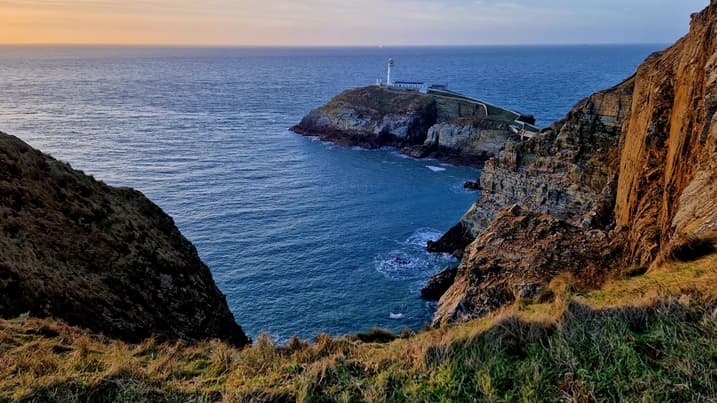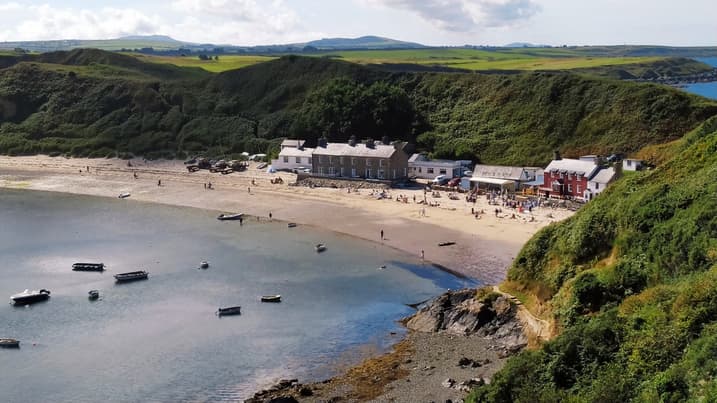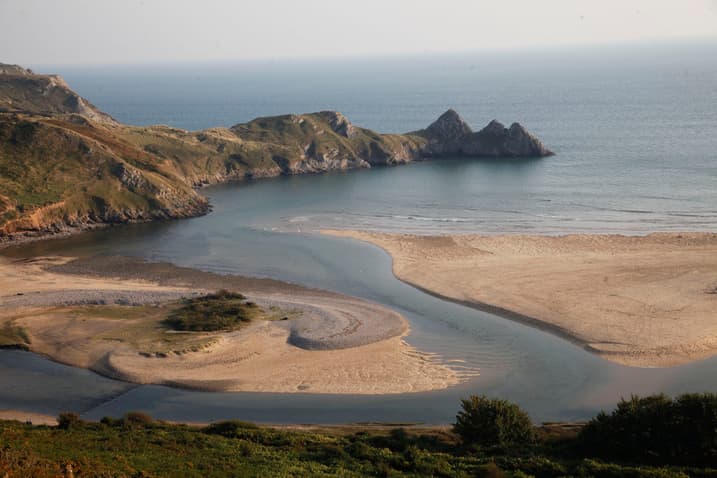In a nutshell...
Funding: £200,000*
Length: 2 - 5 years+
Locations:
Tirweddau Cenedlaethol (National Landscapes):
- Ynys Môn (Anglesey Coast)
- Bryniau Clwyd a Dyffryn Dyfrdwy (Clwydian Range and Dee Valley)
- Llŷn (Llŷn Peninsula) and
- Gŵyr (Gower)
Aim: To bolster habitat for the Chough / Brân Goesgoch (‘red-legged crow’ in Welsh)
Opportunities: Training / volunteer opportunities for communities. Branding and visibility opportunities for businesses supporting Welsh biodiversity. Potential for match-funding.
*subject to additional management fees.

Chough territory around Ynys Lawd (South Stack). Tirwedd Cenedlaethol Ynys Môn (Anglesey National Landscape) (c) Kirsty Brown
The opportunity
Have you seen a red-billed chough? Not many have. This iconic black crow with red legs and a red beak used to be a common sight along the Welsh coastlines and is the emblem for the Llŷn Peninsula National Landscape. Populations have decreased due to habitat degradation, changes in agricultural practices and climate change impacts.
This iconic bird mates for life and tends to build nests in cliff-faces, caves and old mine-shafts, laying eggs that weigh only 15g. They can be spotted foraging for insects and other invertebrates in grazed grassland or flying playfully around the coast making their unique call.
In Welsh, we say 'Brân Goesgoch', meaning red-legged crow. Their Latin name, Pyrrhocorax pyrrhocorax, originates from Greek and translates as the fire-coloured raven, and historically these birds were thought to start fires!
With this project, you have the chance to boost the populations of these glorious birds across four National Landscapes in Wales.

Porth Dinllaen, Tirwedd Cenedlaethol Llŷn (Llŷn Peninsula National Landscape) (c) Kirsty Brown
The project
Choughs are an iconic species of the Welsh coast but have experienced population pressures due to habitat degradation, changes in agricultural practices, and climate change impacts.
This project aims to encourage the recovery of chough populations across four National Landscapes by restoring and enhancing suitable breeding and foraging habitats.
Short-grazed grassland forms their foraging habitat, so the farming community are key to the recovery of this species. This initiative will bring them together with local stakeholders, conservation groups, governmental bodies and researchers to create a sustainable model for chough conservation. Local community groups will be supported to create volunteer and citizen science engagement.
The project’s first phase involves appointing a Development Officer to conduct a feasibility study, engage with landowners, and identify priority intervention sites.
The second phase will involve habitat restoration work, including improved grazing management, coastal grassland restoration, population monitoring and targeted interventions such as nest site protection.
Phase 3 (beyond year 5) will include ongoing monitoring and adaptive management to sustain population recovery. If successful, this project could be rolled out more widely, for example to to encompass National Parks and act as a blueprint for chough recovery in other landscapes.

Bae y Tri Chlogwyn, Tirwedd Cenedlaethol Gŵyr (Three Cliffs Bay, Gower National Landscape)
The chough is an important symbol of Wales’ coastal heritage, and its presence is a key indicator of healthy landscapes. By supporting this project, you will help bring together conservationists, farmers, and communities to ensure that choughs continue to thrive in these National Landscapes for generations to come.
Llŷr Jones, Wales Development Manager
The potential
By getting involved with this project, you can support:
Biodiversity recovery: Supporting the recovery of an iconic bird species in Wales Habitat restoration: Coastal grasslands and cliffside ecosystems will be improved
Sustainable agriculture: Supporting landowners with nature-friendly practices
Community engagement: Volunteer opportunities and educational outreach
Ecotourism: Boosting nature-based tourism through chough-watching opportunities
Climate resilience: Enhancing coastal ecosystem health for broader environmental benefits
Cultural and historical preservation: Choughs have strong cultural significance in Wales, and their conservation supports the preservation of local heritage.
Economic benefits: Connecting farms to future Sustainable Farm Scheme. Potential for increased tourism revenue and job creation through nature-based businesses and guided wildlife tours.
Education and research opportunities: Providing a platform for schools, universities, and citizen scientists to engage in conservation and environmental studies.
Key outputs
- 150ha+ habitat restoration (potential to increase with match-funding)
- Recruitment of a Development Officer to lead project scoping
- Identification of key intervention areas and management strategies
- Development of habitat restoration plans across the targeted National Landscapes
- Engagement with landowners and local stakeholders to implement chough-friendly farming practices Installation and monitoring of artificial nest sites where necessary
- Training and volunteer opportunities for local communities
- Long-term monitoring of chough populations and habitat quality
- Blueprint for chough recovery in other landscapes.
Partner organisations
National Landscapes Association – Project coordination and administration
Local landowners and farmers – Habitat management and restoration implementation
RSPB – Expert advisory role on chough conservation and habitat needs (National and Local teams)
Welsh Government & NRW – Policy alignment and potential funding opportunities
Local community groups – Volunteer and citizen science engagement
Universities (e.g. Bangor, Swansea) – Research and monitoring
National Park Authorities – Input to strategy and implementation across the National Parks as the project expands
Local Environmental Record Centres – Coordinate wildlife records
Are you keen to support these iconic chough populations?
Reach out to the team today.
